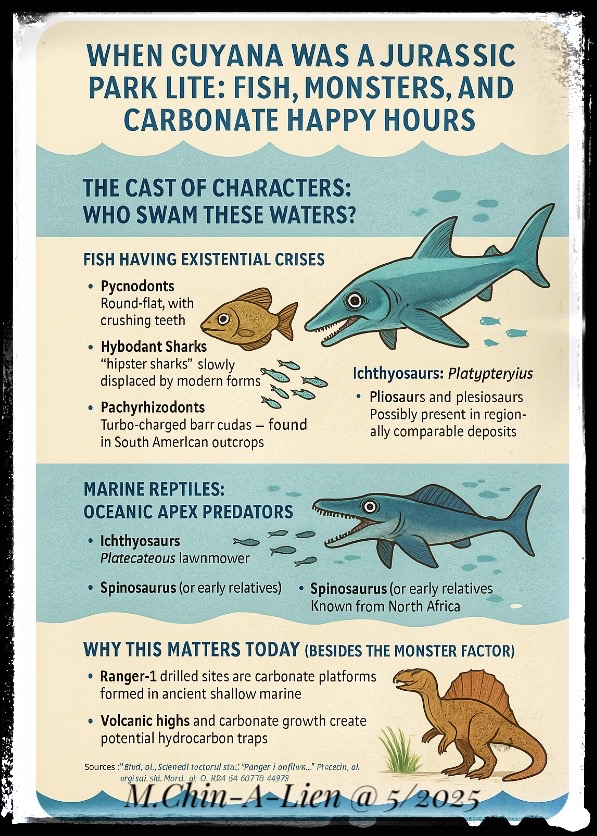The Lower Cretaceous Seas: Where the Real Sea Monsters Partied
145 million years ago, the coastlines of modern-day Guyana and Suriname weren’t just passive stretches of continental margin. They were shallow, tropical seas teeming with bizarre and terrifying marine life—an underwater thriller in slow motion. While dinosaurs ruled the land, the early Aptian carbonate platforms—like those found at Ranger-1—were forming beneath warm waters where prehistoric sea monsters roamed freely, and marine evolution threw everything it had into the mix.
The Cast of Characters: Who Swam These Waters?
1. Fish Having Existential Crises
- Pycnodonts – Round and flat, these were the Pac-Men of the Cretaceous, equipped with crushing teeth to obliterate mollusks and crustaceans.
- Fun Fact: Fossils show wear patterns consistent with shell-crushing diets.
- Hybodont Sharks – Holdovers from the Jurassic, these “hipster sharks” were slowly being replaced by sleeker modern forms.
- Often found in shallow marine carbonate settings.
- Pachyrhizodonts – Think turbo-charged barracudas. Sleek, muscular, and built for ambush predation.
- Fossils from similar age formations in South America confirm their presence.
2. Marine Reptiles: Oceanic Apex Predators
These weren’t your average sea creatures. They were massive, alien, and perfectly adapted to rule the waves.
- Ichthyosaurs (e.g., Platypterygius)
- Resembling muscular dolphins with dinner-plate-sized eyes, they were fast, deep-diving predators.
- Teeth adapted for gripping slippery prey like fish and cephalopods.
-
- Suggested Image: A stylized illustration of Platypterygius ambushing a school of fish.
- Pliosaurs & Plesiosaurs (possibly) – Not yet confirmed in the basin, but likely based on regional comparisons.
- Thick-jawed pliosaurs would have made short work of anything swimming nearby.
3. Dinosaurs Lurking on the Shoreline
While carbonate platforms formed offshore, the coastal zones weren’t much safer.
- Iguanodon – This herbivore was the Cretaceous lawnmower, munching on ferns and cycads near the coast.
- Spinosaurus (or early relatives) – A semi-aquatic predator with crocodilian tendencies.
- Though not confirmed in Guyana-Suriname, its North African relatives suggest a similar niche may have existed.
Why This Matters Today (Besides the Monster Factor)
These marine systems are more than fossil beds—they’re geological gold mines.
- Carbonate platforms like those drilled by Ranger-1 are formed in these shallow marine environments.
- The interaction of volcanic highs and carbonate growth creates perfect traps for hydrocarbon accumulation.
- These fossil-rich carbonates help reconstruct paleo-environments, essential for petroleum system modeling.
The Atlantic: A Young, Chaotic Ocean
At the time, the South Atlantic was still opening.
- The basin was shaped by rifting, subsidence, and episodic volcanism, giving rise to isolated carbonate banks.
- These shallow seas encouraged reef growth, while nearby volcanic highs created accommodation space for build-ups.
What Makes These Carbonates Unique?
- Preservation of Life: Fossils embedded in these formations offer insight into temperature, water depth, and salinity—critical for assessing reservoir quality.
- Reservoir Potential: Porosity is often enhanced by early diagenesis in these shallow marine environments.
- Analogs in Other Basins: Similar plays in the Gulf of Mexico and offshore Brazil have yielded multi-billion-barrel discoveries.
Call to Action: Let’s Talk Deep Time
What do you think lies beneath the carbonates of the Guyana-Suriname Basin?
- Could more sea monster fossils be waiting in drill cuttings?
- Should modern exploration incorporate more paleontology in play modeling?
Drop your thoughts, share this post, or tag someone who digs dinosaurs—or carbonates!
Posted on LinkedIn, 5th May 2025, accompanied by the following text:
Geo-musings on those most terrible Pachyrhizodonts, Ichthyosaurs and Spinosaurs lurking on the shoreline.
While peacefully swimming in the Lower Cretaceous Guiana Suriname Sea.
FYI: prefer to swim in the azure blue Caribben sea of my paradisiac, native #Curaçaooo.
The #Lower #Cretaceous #seas along modern-day #Guyana and #Suriname hosted a diverse array of #marine #life, including unique #fish and #formidable #marine #reptiles.
These #ecosystems contributed to significant geological formations, essential for understanding past environments and #petroleum #resources.
The #carbonates in this region hold potential for future fossil discoveries and exploration insights.
Interesting tip for mudloggers?
Find the first piece of a Pycnodont or Platyptergius?
In the shakers of the mudpit.
And publish it on LinkedIn.
Succes, enjoy.



Leave a Reply